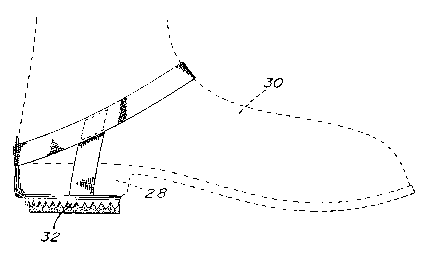Une partie des informations de ce site Web a été fournie par des sources externes. Le gouvernement du Canada n'assume aucune responsabilité concernant la précision, l'actualité ou la fiabilité des informations fournies par les sources externes. Les utilisateurs qui désirent employer cette information devraient consulter directement la source des informations. Le contenu fourni par les sources externes n'est pas assujetti aux exigences sur les langues officielles, la protection des renseignements personnels et l'accessibilité.
L'apparition de différences dans le texte et l'image des Revendications et de l'Abrégé dépend du moment auquel le document est publié. Les textes des Revendications et de l'Abrégé sont affichés :
| (12) Demande de brevet: | (11) CA 2159427 |
|---|---|
| (54) Titre français: | PIECE ANTIDERAPANTE A FIXER AU TALON |
| (54) Titre anglais: | AN ANTI-SKID HEEL ATTACHMENT |
| Statut: | Réputée abandonnée et au-delà du délai pour le rétablissement - en attente de la réponse à l’avis de communication rejetée |
| (51) Classification internationale des brevets (CIB): |
|
|---|---|
| (72) Inventeurs : |
|
| (73) Titulaires : |
|
| (71) Demandeurs : | |
| (74) Agent: | LAVERY, DE BILLY, LLP |
| (74) Co-agent: | |
| (45) Délivré: | |
| (22) Date de dépôt: | 1995-09-28 |
| (41) Mise à la disponibilité du public: | 1997-03-29 |
| Requête d'examen: | 2002-07-23 |
| Licence disponible: | S.O. |
| Cédé au domaine public: | S.O. |
| (25) Langue des documents déposés: | Anglais |
| Traité de coopération en matière de brevets (PCT): | Non |
|---|
| (30) Données de priorité de la demande: | S.O. |
|---|
The disclosure herein describes an anti-skid
heel attachment which comprises a plate with straps for
attaching the plate to the heel portion of a user's foot.
The plate has a horizontal portion to bear under the heel
and a pivotable back plate that bears against the rear of
the heel. The underside of the attachment has frictional
projections to provide the anti-skid feature. The back
plate is pivotable to lie on the top face of the
horizontal plate and the straps are pliable so that the
attachment, when not in use, can be compactingly stored.
A heel substitute is also described to fit under the heel
attachment to serve the normal use of a heel when the
anti-skid feature is not desired.
Note : Les revendications sont présentées dans la langue officielle dans laquelle elles ont été soumises.
Note : Les descriptions sont présentées dans la langue officielle dans laquelle elles ont été soumises.

2024-08-01 : Dans le cadre de la transition vers les Brevets de nouvelle génération (BNG), la base de données sur les brevets canadiens (BDBC) contient désormais un Historique d'événement plus détaillé, qui reproduit le Journal des événements de notre nouvelle solution interne.
Veuillez noter que les événements débutant par « Inactive : » se réfèrent à des événements qui ne sont plus utilisés dans notre nouvelle solution interne.
Pour une meilleure compréhension de l'état de la demande ou brevet qui figure sur cette page, la rubrique Mise en garde , et les descriptions de Brevet , Historique d'événement , Taxes périodiques et Historique des paiements devraient être consultées.
| Description | Date |
|---|---|
| Demande non rétablie avant l'échéance | 2003-09-29 |
| Le délai pour l'annulation est expiré | 2003-09-29 |
| Réputée abandonnée - omission de répondre à un avis sur les taxes pour le maintien en état | 2002-09-30 |
| Inactive : Renseign. sur l'état - Complets dès date d'ent. journ. | 2002-08-12 |
| Inactive : Dem. traitée sur TS dès date d'ent. journal | 2002-08-12 |
| Lettre envoyée | 2002-08-12 |
| Exigences pour une requête d'examen - jugée conforme | 2002-07-23 |
| Toutes les exigences pour l'examen - jugée conforme | 2002-07-23 |
| Inactive : Page couverture publiée | 2000-12-21 |
| Demande publiée (accessible au public) | 1997-03-29 |
| Date d'abandonnement | Raison | Date de rétablissement |
|---|---|---|
| 2002-09-30 |
Le dernier paiement a été reçu le 2001-09-14
Avis : Si le paiement en totalité n'a pas été reçu au plus tard à la date indiquée, une taxe supplémentaire peut être imposée, soit une des taxes suivantes :
Les taxes sur les brevets sont ajustées au 1er janvier de chaque année. Les montants ci-dessus sont les montants actuels s'ils sont reçus au plus tard le 31 décembre de l'année en cours.
Veuillez vous référer à la page web des
taxes sur les brevets
de l'OPIC pour voir tous les montants actuels des taxes.
| Type de taxes | Anniversaire | Échéance | Date payée |
|---|---|---|---|
| TM (demande, 2e anniv.) - petite | 02 | 1997-09-29 | 1997-09-23 |
| TM (demande, 3e anniv.) - petite | 03 | 1998-09-28 | 1998-09-14 |
| TM (demande, 4e anniv.) - petite | 04 | 1999-09-28 | 1999-09-15 |
| TM (demande, 5e anniv.) - petite | 05 | 2000-09-28 | 2000-09-14 |
| TM (demande, 6e anniv.) - petite | 06 | 2001-09-28 | 2001-09-14 |
| Requête d'examen - petite | 2002-07-23 |
Les titulaires actuels et antérieures au dossier sont affichés en ordre alphabétique.
| Titulaires actuels au dossier |
|---|
| FRANCOIS CANDELA |
| Titulaires antérieures au dossier |
|---|
| S.O. |